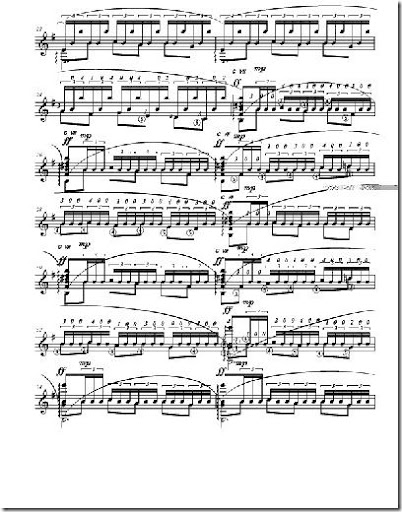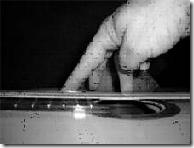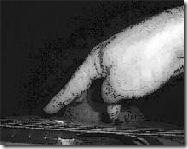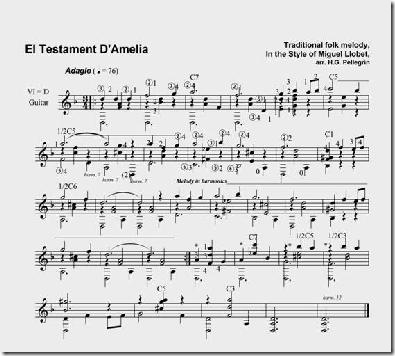The First Noel (arr.Gallagher) in standard guitar notation and tablature (PDF file)
Thursday, December 18, 2008
Wednesday, December 17, 2008
Greensleeves - Intstruction Video
One of the most famous traditional british tune.
Silent Night
A classic Christmas carol adapted for beginners.
Variations on Deck the Halls
Variations on Deck the Halls (arr. Gallagher) in standard notation and tablature (PDF file)
Monday, December 15, 2008
Silent Night - A Christmas Carol
Silent Night in standard notation and tablature (PDF file)
Monday, December 8, 2008
Fernando Sor - Complete Works (Integrale)
Op. 1: Six Divertimentos.
Op. 2: Six Divertimentos.
Op. 3: Theme and Variations.
Op. 4: Fantasia.
Op. 5: Six petites pièces.
Op. 6: Twelve Studies.
Op. 7: Fantasia.
Op. 8: Six Divertimentos.
Op. 9: Variations on a Theme of Mozart.
Op. 10: Troisième Fantaisie.
Op. 11: Deux thèmes variés et douze menuets.
Op. 12: Quatrième Fantaisie.
Op. 13: Six Divertimentos.
Op. 14: Sonata ("Grand Solo").
Op. 15(a): Folies d'Espagne & minuet.
Op. 15(b): Sonata.
Op. 15(c): Thème varié.
Op. 16: Variations on "Nel cor più non mi sento".
Op. 17: Six Waltzes.
Op. 18: Six Waltzes.
Op. 19: Six airs from The Magic Flute.
Op. 20: Theme and Variations.
Op. 21: Les Adieux.
Op. 22: Grand Sonata.
Op. 23: Fifth Divertissement.
Op. 24: Huit petites pièces.
Op. 25: Second grand sonata.
Op. 26: Variations on "Que ne suis-je la fougère".
Op. 27: Variations on "Gentil housard".
Op. 28: Variations on "Malbroug".
Op. 29: Twelve Studies.
Op. 30: Fantaisie.
Op. 31: 24 Leçons progressives.
Op. 32: Six petites pièces.
Op. 33: Trois pièces de société.
Op. 34: L’Encouragement.
Op. 35: 24 Exercices très utiles.
Op. 36: Trois pièces de société.
Op. 37: Serenade.
Op. 38: Divertissement.
Op. 39: Six Valses.
Op. 40: Variations
Op. 41: Les deux amis.
Op. 42: Six petites pièces.
Op. 43: Mes ennuis, six bagatelles.
Op. 44: 24 petites pièces.
Op. 44 bis: Six Valses.
Op. 45: Voyons si c'est ça.
Op. 46: Souvenir d'amitié.
Op. 47: Six petites pièces progressives.
Op. 48: Est-ce bien ça?
Op. 49: Divertissement militaire.
Op. 50: Le calme.
Op. 51: A la bonne heure.
Op. 52: Fantaisie villageoise.
Op. 53: Le premier pas vers moi.
Op. 54: Morceau de concert.
Op. 54 bis: Fantaisie.
Op. 55: Trois duos.
Op. 56: Souvenirs d'une soirée à Berlin.
Op. 57: Six valses et un galop.
Op. 58: Fantaisie.
Op. 59: Fantaisie élégiaque.
Op. 60: Introduction à l'étude de la guitare.
Op. 61: Trois petits divertissements.
Op. 62: Divertissement.
Op. 63: Souvenir de Russie.
FERNANDO SOR (1778-1839)
Introduction.
There was a time, (25-30 year’s ago) that a Classical Guitar recital would seem incomplete without the inclusion of a work by Fernando Sor. Today it is rare for him to be included in a concert programme.
It must be said that his other works , Operas, Ballets, etc., have been silent since his death, and today his reputation rests solely as a composer of guitar music. It cannot be that today’s new generation of young guitarists find his pieces unworthy, as his contribution to the literature of the guitar is undeniable, (the critic Fetis adorned Sor with the title “The Beethoven of the Guitar”). He is acknowledged in the development of technique for the instrument and his collaboration with makers improved guitar construction. In the history of the guitar his name is assured. So why is it that today’s modern players neglect his music in the concert hall?
Present day critics may be responsible for the decline of Sor's exposure to the concert-going public by accusing him of being lightweight, of trying to inject a depth in his music that in the end only made it sound ludicrous, that he was guilty of clichés, (more eminent composers than Sor were guilty of that) and that he was unable to produce extended compositions of distinction. It may be this that dissuades the young guitarists of today from performing his work, so as not to invite negative critical reviews, but, nevertheless, I have always found Fernando Sor`s music (lightweight, clichés and all) pleasing, satisfying and always a delight.
Allegro non troppo
JOSEPH FERNANDO MACARI SORS was born in Barcelona, the actual date is in dispute, but he was baptized on the 14th February 1778. The son of a merchant, he was presumably in a better position than most to obtain a good education. As it was, his musical training took place in the Monastery of Montserrat Choir School. He also studied violin, piano and harmony, but not guitar. I do not know whether Fernando studied any other areas of basic education than music at the Monastery but his time there certainly set him in good stead for his musical career.
It is known that Senoir Sor Snr. owned a guitar so Fernando was familiar with its sound. On leaving the Monastery, he received the customary token of a gold coin from one of the monks with which he bought a guitar which was to become the passion of his life. (The gold coin was supposed to benefit the family of the graduating student).
It is at the age of eighteen that we next really hear of Fernando Sor. A production of his opera "Telemachus on the Calypso's Isle" performed in Barcelona in 1797 was very successful and led to a patronage in the service of the Duchess of Alba who apparently doted on the young composer. It is also at this time that Fernando was enlisted in the Spanish army, making the rank of captain in the Cordovan volunteers. It is also from this period that his first important guitar compositions can be charted. The premature death of the Duchess of Alba in1802 left Fernando without a patron, but luckily he found employment with the Duke of Medinaceli. His luck was not to last long: the French, under Napoleon Bonaparte invaded and occupied Spain.
Napoleon placed his brother, Joseph, on the throne of Spain and some more forward-thinking Spaniards thought that his puppet government would put into motion much needed political reforms. Fernando Sor was one of these French sympathisers (Afrancesados) and sided against the deposed Spanish King ,Charles IVth. So it was, when the French were defeated by Wellingtons army and had to withdraw, Fernando was obliged to leave with them. (This is a controversial issue; some scholars maintain that Sor was a Spanish patriot, and while I do think he believed that his association with the French was in the best interests of his own country, the fact remains he left Spain never to return. This implies that Sor must have regarded his actions as being perceived by his fellow countrymen as fraternising with the enemy and therefore treasonable).
Sor took residence in Paris and continued his musical career, encouraged by other prominent composers such as Cherubini and Berton. This was a productive time for Sor which saw him composing Operas, Ballets, Symphonies and Songs as well as guitar pieces.
In 1815 Sor went to England and with his virtuoso playing captivated the English guitar fraternity. On March 24th 1817 he performed his “Concertante for guitar, violin, viola and cello” at the Philharmonic Society to great acclaim. (This work is not included in Sor`s Opus listing and may be lost). By 1822 he became an Honorary Member of the Royal Academy of Music, which is a tribute to his personality and his musicianship.
Sor`s musical ambitions then took him to Russia, arriving in Moscow in November of 1823. His talents were soon appreciated and before long he was mixing with the highest level of Russian society, playing for the mother of Tsar Alexander 1st and the Royal family. When the Tsar died in 1825, Sor wrote a funeral march which was played at the funeral in St Petersburg. Returning to Moscow he produced the premiere of his ballet “Cendrillon”.
By 1827 Sor was once again living in Paris. The instrument was enjoying an revival of popularity and other famous guitarist/composers such as Dionisio Aguado (1784-1849) and Ferdinando Carulli (1770-1841) were in the French capital at this time. Sor struck up a friendship with Aguado that prompted many of Sor`s duet pieces, which they frequently performed together. As well as giving concerts he also had guitar pupils, many of them ladies of high society. This is probably also his most productive period of compositions for the guitar. They were now also available to buy, being published by Antoine Meissonnier in sixteen volumes. (Sor would later use the publisher Pacini). Sor eventually published his works himself which included ,in 1830, his “ Methode Pour la Guitare”. This is a fascinating insight into the foundation of Sor`s view of the technique and thought process of guitar playing, acquired over a life times experience. All aspects are examined in detail, starting with his preferred make of instrument, sitting posture, the bodies relationship to the instrument, left and right hand positions, logical use of the fingers of both hands and the manner in which the right hand finger tips strike the strings. (Sor never advocated the use of the nails which was preferred by Aguado. This must have made an interesting, if not entirely compatible sound in their duet ensemble). Presumably Sor`s own technique was more than adequate to play all of his own compositions which indicates that even by today’s standards he must have been a formidable guitarist.
Fernando Sor`s last years were not happy ones. Both his wife and daughter died suddenly, one very shortly before the other. He himself suffered from cancer of the tongue and died in great pain on July 8th 1839. Buried in the cemetery of Montmartre, Paris, in the tomb of a friend, with no inscription, the last resting place of the greatest guitar composer of the nineteenth century was not identified until1934.
Theme and Variations.
The legacy that is Fernando Sor`s guitar works are listed in 63 opus numbers. These range in style and forms such as Divertissements, Theme and Variations, Fantasies, Waltzes, Sonata’s and groups of Studies etc., plus Duets. (Recently a number of lost pieces have been rediscovered, for example “Fantasie pour guitar seule” in D, which as yet carry no opus numbers).
The Studies, written periodically throughout his life, number almost one hundred, involve techniques of playing in thirds, arpeggios, rapidly repeated notes (tremolo), staccato chords, in fact all aspects of guitar playing is thoroughly covered. A compilation of 20 of the Studies from Op. 6, 29, 31, and 35 were compiled by Andre Segovia (1893-1987) who frequently performed a selection of them in his recitals. Make no mistake these Studies are not just exercises but valid pieces of music in their own right, albeit in miniature. Probably the most famous of Sor's works is his Op. 9. (1821) “Variations on a Theme of Mozart” the theme being “O Cara Armonia” from the 2nd act of Mozart’s “The Magic Flute”. In the hands of a virtuoso this becomes a dazzling tour de force that displays the skills of the guitarist and the imagination of the composer. When writing extended works like Sonatas, Sor never tried to emulate the piano or violin works of the same genre. He knew the strengths and weaknesses of the instrument and wrote for it accordingly. A good example of this is his “Sonata in C” Op. 25. (1827). It is unusual in as much that normally the first movement of a Sonata uses the Sonata Form, but Sor's Op. 25, opens with a long Introduction in C minor and the Sonata Form appears in the second movement, an Allegro non troppo, which moves to the tonic of C major. There then follows a Theme and Variations and it ends with a quick Minuet and Trio instead of the usual Rondo.
The duets ,which occupy 12 of the opus numbers, vary in scale from short pieces like his set of “Six valses faciles” Op. 44 bis. (1831) to longer works like “Les deux amis” Op. 41. (1829-30) with the parts labelled “Sor” and “Aguado” and the well known “L`Encouragement” Op. 34. (1828). (This has the dedication “une de ses élève”). The parts of this are labelled “L’élèves” and “Le Maître” indicating that the pupil play the more difficult melody line while the teacher has the accompaniment. (A pupil of Sor, Napoleon Coste (1806-1883), would later rearrange this work, sharing the parts in a more democratic way). A less well known duet is “Divertissement” Op. 62. (c1837-38) where the movements are Andantino Cantabile followed by a Polonaise (the Polonaise is rare in Sor`s music) and is a wonderful example of duet writing. It is a shame that it is not performed more often, perhaps because a prodigious technique is required by both guitarist.
Finale.
Performing any composers work requires thoughtful consideration. Julian Bream (b. 1933) gave an insight to his thoughts and approach to playing Sor when in conversation with the late Peter Sensier on BBC Radio 3`s programme “The Classical Guitar” in the early 1970`sHere are some extracts.
“An important factor in his (Sor`s) music is its charm. It has its use in music, and I for one, am quite prepared to be charmed, not twenty four hours a day, but I think on occasion”.
“I think Fernando Sor does have to be played with respect but for a certain type of innocence in his music. I think to over apply romanticism to the music is a great mistake. There is a classicism for example not unlike Mozart in his style which to my mind is a style of beautiful understatement. But if you give understatement space and time, it has a positive element that transcends the simplicity or the innocence of the material. Sor needs immense care and affection, and if one invests his music with that, I can’t see how anybody can object to it”.
Friday, December 5, 2008
Christmas music for classic guitar
Here is my collection of Christmas music Scores
- Angels We Have Heard On High
- Blue Christmas
- Deck the Halls
- Hark! The Herald Angels Sing
- It Come Upon the Midnight Clear
- Jingle Bell
- Joy to the World
- Little Drummer Boy
- O Christmas Tree
- O Come All Ye Faithful
- O Holy Night
- Silnet Night
- The First Nowell
- We Wish You a Merry Christmas
- White Christmas
- Away In a Manger
- God Rest You Merry, Gentlemen
- Ding Dong! Merrily on High
- Good King, Wenceslas
- O Little Town of Bethlehem
- Once in Royal David's City
- Rocking
- See Amid The Winter's Snow
- The Holy and The Ivy
- While Shepherds Watched Their Flocks
PLUS MORE.....................
Thursday, December 4, 2008
Marcin Dylla plays Rossiniana no.1 at Wawel Royal Castle for the first time in history!!
The piece he plays is "Rossiniane"no.1 by Giuliani.He plays guitar by Boguslaw Teryks.The guitar has a "sandwich top" and is extremely powerful.
Tuesday, October 21, 2008
School of Guitar: Exposition of Instrument Theory by Abel Carlevaro
Abel Carlevaro, an exceptional virtuoso, composer and teacher born in Montevideo, Uruguay is not only one of the most important guitarists of our time but the creator of a new school of instrumental technique as well. He has been recognised as an exceptional performer worldwide and has gained the admiration and esteem of musicians such as Heitor Villa Lobos and Andr�s Segovia. His performances in the most important music centres in Europe, Latin America and the United States have been acclaimed with high praise by the public and the critics alike.
Carlevaro is a devoted composer. His musical production ranges from his "Preludios Americanos" which already form part of the repertoire of renowned guitarists in America and Europe, to his "Concierto No 3 para Guitarra y Orquesta" composed by request of and played for the first time by The Chamber Symphony of San Francisco. Other contemporary I ensembles of renown such as The San Francisco Contemporary Music Players and The Kronos Quartet have also performed some of Carlevaro's works for the first time. His "Concierto del Plata" for guitar and orchestra has been interpreted by important European and American symphony orchestras.
A profound and dedicated teacher, Carlevaro is the creator of a new school of instrumental technique, a fundamental milestone in the evolution of the guitar expounded in his book "Escuela de la Guitarra Exposici�n de la Teor�a Instrumental" (School of Guitar Exposition of Instrumental Theory), in the didactic series the "Cuadernos" as well as in the "Carlevaro Masterclass" series. These pedagogical works as well as his compositions and transcriptions are edited by Boosey and Hawkes of New York, Chanterelle Verlag of Heidelberg, Barry Editorial of Buenos Aires and Henri Lemoine of Paris.
An indefatigable researcher, Carlevaro has also invented a new guitar, the conception and design of which break away totally from traditional guitar making.
Every year Maestro Carlevaro offers Masterclasses in Europe and America and is often invited to take part in juries at international competitions for interpretation and composition. To acknowledge his exceptional merits and his relevant work in music, on March 18, 1985 the Organisation of American States granted Abel Carlevaro its highest honour, the prestigious Diploma de Honour, and in 1987 the Government of Venezuela, in public ceremony, honoured him with the Order of "Andr's Bello".
The book is the English language version of Escuela De La Guitarra.
School of guitar is a must for students of classical guitar. These techniques are vital to any guitarist. The concentration of arm movements and isolation of each hand are essential to improving technique. This is a great book to learn the modern techniques for the modern classical guitar.
Sightreading made easy for guitar
This book will guide you through a very attractive way to learn sightreading in a remarkably very short time.
The Art of Rasgueado
The rasgeuado technique is without a doubt the most impressive and characteristic element of the flamenco guitar. Author Ioannis Anastassakis has studied and researched the rasgueado technique of every significant flamenco guitarist in the world, and has compiled his work in this book in an easy and understandable notation form, with excellent explanations of each rasgueado technique. From this book, every flamenco and non-flamenco guitarist, from aficionado to professional, can learn everything about the rasgueado technique and its interpretation. Rumba rhythms and the golpe technique are also discussed. Notation and tablature.
Monday, September 15, 2008
Complete Transcription of Baden Powell
Brazilian music inspires the most beautiful and expressive feelings from a composer's heart. Such is the case with this gorgeous Choro by the Brasilian guitarist Baden Powell. Powell definitely made his guitar sing and he added to both Bossa Nova and Brazilian music in general, a unique flavor, one that most guitar players can only attain to achieve. He died in 2001 in Rio de Janeiro at the age of 63... booze and tobacco shortened this talented musician's life.....
His last concert was only days before his death in Belo Horizonte.
Baden Powell was born on August 6, 1937, in Varre-Sai, a little town in 220 miles from Rio de Janeiro. His father, a shoemaker, boy scout leader and tuba player in his free time, named the son after Sir Baden-Powell, the British soldier who in 1908 founded de Boy Scouts.
He started to play jazz in Rio's nightclubs. He would soon meet and become friends with such bossa nova icons as Tom Jobim and Vinicius de Moraes. His first hit came in 1956 with "Samba Triste".
Brasilian portrait is a jewel of Universal proportions. A special appoggiato effect is used in the right hand to bring out the amazing depth of the melody.....
Tuesday, September 2, 2008
A Complete Mel Bay Method of Classical Guitar
This is a good book for Classical Guitar. However, I only have Volume 2. Anyone has volume 1, please contact me if you want to share.
Thursday, August 28, 2008
Why Transcribe? We look at a Bach Cello Suite.
Bach's First Cello Suite in D
One of the best exercises for the guitarist is to transcribe pieces penned for other instruments into guitar renditions. Why is this so beneficial? Well, we often play music specifically composed for our instrument and these pieces are written guitaristically. The composer knows the limits of the instrument -- or at least what he or she feels are the limits -- and then crafts a melody that fits these preconceived notions. Limits and constraint are the result.
Taking a piece written for the piano (like Albeniz' material) or the piece we will be exploring -- Bach's First Suite for unaccompanied cello -- means we are forced to think outside the parameters we expect and get used to with guitar-specific pieces. Wit the Bach piece, we are forced to put ourselves into Bach's mind and determine what harmonies he was implying with double stops on the cello -- very few complete chords, but much implied, subtle and sublime harmonies can be heard. Whenever you are attempting a transcription, it is necessary that you not only have a benchmark edition of the piece specifically for the original instrument, but it is also a blessing to have a resource that shows the composer's original edition -- like the Bach Gesellschaft. In the case of the Bach, numerous editions as well as Gesellschaft facsimiles are available. What I've done here is reproduced my transcription of the Sarabande of the First Cello Suite. You will note that there are harmonies that could not be played on the cello -- just try a six-note chord.
Wednesday, August 27, 2008
Carulli and a few new Karma Sutra positions - Part 3
Last time we looked at Carulli's neat exercise in fifth position. Here is his concept of sixth position
:
As I stated last time, many good players think of the fifth position (fifth fret) as a clean and neat place to play in the keys of A and D major and minor. This is not bad thinking. Carulli gives us F Major in fifth position! It works, it is logical, it is a useful tool to know.
Much the same, when Carulli takes it up a notch to the sixth fret, he winds up NOT in B flat and E flat, but in F sharp! -- like you didn't see that coming.
But wait, there is more to come....
Carulli and a few new Karma Sutra positions - Part 2
Last time we looked at Carulli's neat exercise in fourth position. Here is his concept of fifth position
:
Many good players think of the fifth position (fifth fret) as a clean and neat place to play in the keys of A and D major and minor. This is not bad thinking. Carulli gives us F Major! It works, it is logical, it is a useful tool to know.
Tuesday, August 26, 2008
Carulli and a few new Karma Sutra positions, well actually one new position on the guitar.
As discussed earlier, violinists learn the fingerboard (and sight-reading) in position. Guitarists learn the notes in the open position, then learn the barré chords and pentatonic box and consider themselves as having arrived. Few can sight-read well above the third fret. That is why so many 'serious' instrumentalists consider us guitar players to be sub-par morons. We is. Carulli's Method (penned way back in the early 1800's -- probably in Linear-A and on stone tablets -- was a more traditional pedagogical approach. He taught left-hand positions. While this is not necessarily going to render you an awesome sight reader for modern music, or even guitaristically composed pieces of any time period, his approach will yield a superior sight-reader than most of our contemporary brethren will ever aspire to be.
In the following exercise that was edited from the Carulli Method, we see a scale-arpeggio study in E Major that is played entirely with stopped strings utilizing notes found on the fourth through seventh frets. Please DO NOT read through this and use any open strings or open position notes that you learned in Mel Bay volume One. Please follow the fingerings that I have added after, gosh, minutes of careful thought.
You'll be surprised how many times you'll reach for the open position. I know I was and did.
Giuliani is great but a bit harmonically challenged!
Almost heresy. And you know by now that I sincerely love Giuliani. You've seen the 120 Studies for the Right Hand. They are awesome and necessary pedagogical technique studies. But, BUT! Flipping from C major to G7 to C major for the amount of time it takes to run through the entire 120 Studies will leave you with a sonic hangover.
Larry Silvestro, noted double bassist, guitarist and teacher suggested using other chords, i.e., run the thing with E major and B7 for a while, swap out to A major, try some minor keys, you get the idea. What I did eventually was make up my own series of exercises utilizing all the right hand patterns that Giuliani suggested and then string them together to form a continuous 'piece'. If you own the 120, go through them trying this kind of trick. If you don't won the 120, consider getting them -- soon. With those ands the Carulli Right Hand Studies, you've got the issue covered!
Check out this brief excerpt of what I did to Giuliani.
Monday, August 25, 2008
Sor's Etude Number One can still teach a few things after a century and a half or so
Fernando Sor's Etudes
I use it with good reason. Everyone has the notion that if it wasn't written in the 20th century, then it must be quaint, old-fashioned and probably useless for pedagogical uses. Fernando Sor was probably one of the greatest lights of the guitar firmament. In fact, Sor, Giuliani and Carcassi stand to me as the trinity of the guitar canon. Yes, Tarrega, Coste are BIG as well, but the other three were earlier. Him that hits first with the most... These guys blazed the trail. Everyone else broadened the way.
What sets Sor up as a demigod of pedagogical excellence is the fact that he covered so many technical aspects of the guitar with his Etudes -- and he made these Etudes pleasant for the student. They are musical as well as helpful. High art? Naw, go to Sor's recital pieces for sumptuous classical period composition.
The rendition below comes courtesy of The Guitar School of Iceland. This is a must-visit website of free sheet music downloads. The student can visit this site and download just about anything from the standard repertoire and pedagogical library. One can go from novice to recitalist with the music available here.
The Study shown here is useful for a couple of technical skills. First, I feel that Sor is trying to get the student to listen to the voices in chords and how they should be brought forth. The melody begins in the bass in measure one, going to the middle in the second measure. Look at measure six, seven and eight. Try accenting different notes in those measures. The last two lines contain a couple of nice finger twisters. You should make sure that his or her fingerings allow the notes to ring for their written values.
When played correctly, this is a very nice little piece. High art? Probably not. Enjoyable for the new student? Yes. It's a pleasant way to learn some good technique. Hey, that's what studies are all about!
Playing versus practice
"Sure I practiced... I played at least an hour every day this week." Yup, that student did indeed have the instrument out of the case for at least an hour each day during the previous week. He even had the thing in his hands and made noise with it. So why did his lesson sound just as lame as on the first read-through the week previous? Is he a bad player? Did he suffer a sudden catastrophic injury to his hands? Did his truss rod pop out? Nope, nope, nope.
Practice and playing are two very distinct beasts. As soon as the student realizes this, the happier the teacher will be. Yeah, the student will be a happier camper as well.
Practice is how the instrument is learned. Wait, I thought going for lessons is how it's done! Now every teacher on the planet will be all over me like a wet diaper -- at least those who wish their students to think that that particular teacher is the only true path to enlightenment -- but the lesson time is not the most important aspect to a musical education. Lesson time is when a new concept or technique is introduced. Lesson time is when the previous week's assignments are heard, critiqued and problems corrected. Lesson time is when good practice habits and musicality are instilled. Practice is when the student takes these concepts and attempts to incorprate these into his actual being as well as into his skill sets on the instrument itself.
Playing is a totally different beast. Playing --performance-- is when you take everything you've learned through instruction and practice and put it into.. into... Well, I was going to say practice, but that is too redundant! Playing is why you learn and practice. It is not how you improve on the instrument. You can improve through playing, but only in gaining poise and performance savvy, but that is another tale for another day -- and only if you are playing in front of people, not just playing on the sofa to your cat.
So what is practice? How should one practice? Is there a formula?
Practice time should be regimented, structured and adhered to religiously -- a solid practice routine will grow a student faster than master classes with Segovia... while he was alive, naturally. Yes, there is a formula for practice. I can tell you mine, but a practice schedule is as varied as the individuals doing the work. Here is how I practiced in college:
Hour One:
Ten minutes: Chromatics, Slurs, Stretches and Barres (see some of the early weeks' sessions and the left hand accuracy article for details.) I even would run through a portion of the Giuliani 120 Studies.
Forty minutes: Diatonic Major and Minor Scales (Segovia Edition -- he was still alive then, but his scales remain with us to this today, a valid, living thing.) Played with all combinations of right hand fingerings that I could muster, including some rapid thumb work.
Ten minutes: Cool down.
Hour Two:
New assignments and read-throughs. This is where I took new studies, preludes and concert pieces assigned by my teacher and read them through for the second or third time, looked for the underlying technical difficulties/lessons and tried to glean the most benefit from them. By doing this fairly early in the day, I could give my best and brightest moments to the most strenuous mental tasks. I would use the entire hour for this without cool down as there would be alot of starting and stopping anyway.
Hour Three:
Pieces I was in the process of committing to memory with a school jury, recital performance or the looming graduation recital in mind. These were usually stuff that I had been using in hour two a month previous. Now they were no longer technically difficult -- or at least as difficult as they had been -- but were now no longer the "News of the Day." Hour three would incorporate a cool down if I were proceeding to hour four. Usually, on a week day, I had begun this process at 6:30 AM and would have to be off to classes at this point.
During the school day, there would be numerous opportunities to play -- even practice. I had a schedule with some gaps where I would either be running through ensemble pieces with others or would be playing old pieces in a closet by myself. I didn't count this time as practice, to me it was playing.
Hour Four through Six:
After One of my Mom's great dinners. I'd be off to my room to resume the practice schedule. Written homework was completed on the subway train. (And if you want to know genuine fear, try riding the NYC subway system through the South Bronx in the mid 1970's with a Jose Ramirez 1a between your knees.) The after dinner practice was more 'playing' in one respect -- I used this time of the day, a time when my mental levels were beginning to run low, to run through pieces that I knew I would be performing soon. Be it a student recital, a restaurant gig, or that aforementioned graduation recital, I needed to keep a solid 90 minutes of music ready to go. So I used this time to run through the pieces, ever mindful of places where I'd fumble through memory lapse as well as looking for new interpretive ideas while I played the established ones. I'd often read through a piece I had already committed to memory to make sure I hadn't locked something down incorrectly.
If it was before midnight and I still felt like it, then I would play for my own entertainment. I'm glad I did that all when I was young. A month of that type of work now would probably kill me!
So... How should you set up your time? Let's say you are at the point where two hours a day is all you have to work with. You don't want to do two hours straight. It isn't as much 'how long you play every day', but how often you had the guitar in your hands. It is better to do four half-hour sessions spaced out evenly than one marathon two hour hand-bash.
First, you need to warm up effectively. Schedule about a quarter of your time to scales, slurs, arpeggios, chromatics, whatever you do to get limber. The next and most profitable time is spent going through your weekly lesson material. Do this while your mind is fresh. It doesn't pay to play all day and then try learning new material in the evening. You will be throwing things in no time through frustration. Spend at least half your remaining practice time on that -- practicing new stuff, reading new pieces, copping new technique. This is development. Any time remaining should be used to run through memorization and older material. After that, play.
Sounds like work? It is -- if you love the instrument and want to do well, it is work you'll gladly do. If you get discouraged at your inability to sound like Eliot Fisk after six months of lessons, maybe you're a hobbyist, not a recitalist. That's not condemnation, not everyone who feels compelled to offer a band aid is destined to be a cardiac surgeon! Sorry if that sounds harsh, but music is not a neat way of attracting members of the opposite sex or a sure-fire route to money and fame. You have to love music, not that other stuff. Man, it's hot and I'm getting cranky,
Saturday, August 23, 2008
Edition Fingering: Is it right for your hand? Is it right for the music?
In any guitar music, be it a piece specifically written for the guitar or a transcription from another instrument’s repertoire, there will be suggested/recommended/required fingering added by the composer, transcriber or an editor. Some players treat these as sacrosanct; others disregard them and follow their own ideas of physical comfort, their belief re the intent of the composer/transcriber. Most guitarists beat a path somewhere in the middle ground whereupon they follow the fingerings in their chosen edition making changes only if absolutely necessary – if they believe there is a mistake in the edition or if a facsimile edition of the composer’s work indicates a different fingering.
Often none of these considerations make the ‘change’ in the fingering. Most often it is a fault of memorization. When one memorizes a piece, there is always the possibility that although something sounds right, it is being memorized incorrectly. This is why it is critical to memorize any pieces with the music on the stand in front of the guitarist. It is also critical to go back to the printed page every so often to ascertain whether the performer has unintentionally changed things—including actual notes – with the fingerings.
Of course, there are times when the guitarist immediately discounts an indicated fingering on the initial read-through and proceeds to use this fingering to the detriment of the performance. How? I will use the following example from Albeniz’ beautiful piece Sevilla.
I have played this piece for a number of years. I use a combination of the Francisco Tárrega and Manuel Barrueco transcriptions. The first measure of the particular phrase above is fingered per the Barrueco transcription. The second measure is how I played it. Note the only difference—a half barré at the eighth fret rather than the full barré. I would always become apprehensive as this phrase approached during any performance. Sometimes I’d execute it cleanly, sometimes not. After many times of checking the actual notes played, I finally went back to look at the music carefully paying particular attention to the fingering. The photograph to the left shows my version of this chord utilizing a half barré at the eighth fret. To jump into this formation, my wrist had to change position rotating towards the heel of the neck. This is where my difficulty came in. Unless I rotated my wrist correctly, the half barréd notes on the fourth, third and second strings would often be muffled. Hence my apprehension when this measure approached. Well, after years of this aggravation, I looked carefully at the fingering and tried the full barré.
See photograph to the right. Instantly, I could jump up into this chord and nail it cleanly, perfectly, forcefully – every time!
Of course, I had to know why this remarkable miracle was occurring. When I first learned Sevilla, I was more concerned with making sure I had the correct harmony/chords in this passage. It is a critical passage, very dramatic, as a turnaround into the original motif. Being a fond proponent of using as little energy as possible to execute a piece, I probably figured the half barré was more than adequate to take care of two notes on adjacent strings on the same fret. I did not factor in the wrist motion and committed my faulty fingering to memory. On consequent read-throughs, I made certain the notes were correct, but never looked twice at the fingering.
So a fingering that seems to force one to expend more energy is actually more comfortable to execute. In this instance it is more productive to invest a bit more energy to get an easily replicated phrase than to save a bit and waste a clean performance!
Giuliani Practices What He Preaches
Mauro Giuliani (27 July 1781 – 8 May 1828)
Giuliani is reckoned by many to be one of the leading guitar composers and virtuosos of the 19th century. Although born in Bisceglie, Giuliani's center of study was in Barletta where he moved with his brother Nicola. His first instrumental training was on the cello—an instrument which he never completely abandoned—and he probably also studied the violin. Subsequently he devoted himself to the guitar, becoming a very skilled performer on it in a short time.
In Vienna he became acquainted with the classical instrumental style. Giuliani would propel the guitar away from the simple accompaniment of folk songs. In 1807 Giuliani had begun to publish compositions in this style. His concert tours took him all over Europe, and wherever he went he was acclaimed for his virtuosity and, as importantly, his musical style and sophistication. He achieved great success and became a musical celebrity, arguably equal to the best of the many instrumentalists and composers who were active in Vienna in the opening years of the 19th century.
Giuliani defined a new role for the guitar in the context of European music. He was well acquainted with the brightest luminaries of Austrian musical culture and with such noted composers as Rossini and Beethoven, and often worked and collaborated with the best active concert musicians in Vienna.
While in Vienna Giuliani some had minor success as a composer. He worked mostly with the publisher Artaria, who published the large part of his works for guitar, but he had dealings with all the other local publishers, who spread his compositions all over Europe. He developed a teaching reputation as well.
In 1819 Giuliani left Vienna, mainly for financial reasons: his property and bank accounts had been confiscated to pay his debtors. He returned to Italy, spending time in Trieste and Venice, and finally settling in Rome. There he did not have much success; he published a few compositions and gave only one concert.
Four years later he returned to Naples to care for his seriously ill father. In Naples Giuliani would find a better reception to his guitar artistry than he had in Rome, and in Naples he was able to publish works for guitar with local publishers. Toward the end of 1828 the health of the musician began to fail; he died in Naples on the 8th of May, 1829.
As a guitar composer he was very fond of the theme and variations form— a musical device that had been extremely popular in Vienna. He had a remarkable ability to weave a melody into a passage with musical effect while remaining true to the idiom of the instrument. One example of this ability is to be found in his Variations on a theme of Handel, Op. 107. This popular theme, known as "The Harmonious Blacksmith", appears in the Aria from Handel's Suite No. 5 in F for harpsichord. Giuliani completed 150 compositions for guitar with opus number. These compositions constitute the core of the guitar repertoire during the 18th century. He composed extremely challenging pieces for solo guitar.
Notable pieces that stand out from his body of works include his three guitar concertos (Op. 30, 36 and 70); six fantasias for solo guitar, Op. 119-124, based on airs from Rossini operas and entitled the "Rossiniane"; several sonatas for violin and guitar and flute and guitar; a quintet, Op. 65, for strings and guitar; some collections for voice and guitar, and a Grand Overture written in the Italian style. He also transcribed many symphonic works. Even in the Twenty-first Century, Giuliani's concertos and solo pieces are performed by professionals and still demonstrate the guitarist’s mastery of technique and musical eloquence, as well as Giuliani's stellar compositional gifting for the guitar.
Giuliani's treatise 120 Exercises For The Right Hand has become a pedagogical staple and will remain so as long as teachers set about to instruct novices on the classical guitar. It is harmonically challenged as I have mentioned before, but I have actually had students (well, one) tell me that there is no earthly reason to work these 120, as they will not be oft encountered. Despite the fact that I could not just spit out an example off the cuff, I still know in the very fibre of my being that Giuliani's exercises can be spotted throughout the standard repertoire--and the non-standard as well! I know it might seem a bit self-serving for Mauro himself, but I quickly pulled the following piece from my bag of tricks.
In 700 Years of Music for the Classic Guitar, Albert Valdés-Blain included his edition of a Scherzo by Giuliani that he had culled from a first edition from the very early Nineteenth Century. In the following excerpt one can see repeating rhythmic patterns. These patterns are found in the 120 as well (or at least very similar patterns.) I will be scouring the non-Giuliani repertoire to find additional examples, but this one interests me as no one plays it any more. Actually, I just did a recording of it. As simple as it is, it is a lovely little piece and despite the fact that it is something most second or third year students can play with one hand, I found it fun and a nice vehicle for my interpretive output.
The second measure in the excerpt is exercise one, plain and simple -- actually simpler. The bass remains constant -- as does the upper register! Measures seven through eight and ten through twelve are, I believe, to be found in exercise twenty-nine. I have included these (one and twenty-nine.)
The Importance of Practicing Scales
(Yes most find them boring, but they area necessity!)
Scales are useful for a number of purposes. First, scales reinforce the concept of key and tonality as they relate to the fingerboard. Knowing scales helps the sight-reader anticipate what notes he or she may encounter and where they might be played.
Second, scales serve as a wonderful daily warm-up drill. What better way to invigorate the hands while the mind is still rebelling against discipline? Why are they a wonderful warm-up drill? Scales allow the guitarist the time and progressive resistance to limber the muscles of the hands and arms gradually. There are very few (if any) players who can jump out of bed in the morning and play a blindingly quick-tempo’d virtuoso piece. Muscle strain will result from the attempt. By playing scales very slowly, one allows the muscles to loosen up and blood flow to increase. Once warmed up, the virtuoso piece flows easily and the muscles do not rebel. Practice with a metronome. This strictly regulated practice should not be initially intended for speed. Indeed, it is easier in many ways to play scales quickly. Practice slowly—it is then that you will hear any inconsistencies in tone and volume between right hand fingers AND have the opportunity to correct sloppy or incorrect left hand placement and fingerings. Slow metronomic practice of scales will also offer the opportunity to work methodically on vibrato. (See section on vibrato in this volume.)
I have grouped the scales together by key signature, giving the three forms of minor scale in each instance. Is it recommended that the student practice the natural and harmonic minor scales on a daily basis? Not necessarily. Hence the simple ‘cheat-sheet’ entitled “Daily Survival Scales.” These scales are simply the moveable (sliding) forms of the major and melodic minor scales that will cover all the key signatures. It is rather brainless and repetitive, but this is just the ticket for an easy warm-up!
Right hand fingering is simple. Alternate first and second fingers (i, m), then repeat the scale reversing the fingers (m, i). Proceed to the second and third fingers and repeat similarly. It has been noted that most students’ second and third fingers are weaker than the first and second combination. I strongly recommend repeating the two arrangements of the second and third fingers for a total of six repetitions of each scale. This practice will build up the weaker fingers. Do this with free stroke first. Repeat the entire scale regimen with apoyando (rest stroke). It is imperative that the student should be as strong as possible with both types of stroke.
Friday, August 22, 2008
Villa-Lobos Prelude One
Heitor Villa-Lobos' Prelude One
Let's start at the beginning and look at Prelude One in E Minor. The opening begins with what has been described as a "cello-like" line and tone performed upon the fifth and fourth strings with a harmonization executed on the trebles. New players beware: the melody in the bass takes prominence, not the accompaniment!
Please note the tempo markings and accents added. I think I may have scribbled in the vibrato markings and their releases. Looks like my poor handwriting. I was told to rasgueado the chords in the 3/8 section although it looks like a thumb might do the trick. I like the Spanish flair of the rasg. Personal taste. I tend to play the following eighth note chord and harmonic almost staccato. Personal taste again. Try it and see what you come up with. There is no wrong answer!
Villa-Lobos Prelude Two repeats the left hand fingerings quite a bit.
Villa-Lobos Prelude No.2
I own the wonderful old Max Eschig Edition published in Paris in 1954. It lists this prelude as being in c minor (en do mineur) but I really think of it as 'mi majeur'. Maybe it's just me... The piece contains a characteristic Villa-Lobos concept -- a trademark, if you will. What is it? A repeating figure wherein the left hand fingering stays unmodified while the left hand slides from position to position forming a melody or melodic device.
Here take a look:
In the first measure after that double bar (the beginning of the 'B' section) we are introduced to the fingering that will remain 'under hand' for the majority of the section. The last seven measures contain a different left hand positioning, but it too stays steady for those seven measures. So, with that all said, why do I consider this piece an exercise (aside form obvious reasons?) And what exactly is the intent of the exercise? Is it to build up strength in the left hand by holding a pseudo-barré? Could be. I think it is a neat right hand workout as well. The thumb must pluck two notes (almost) simultaneously then the fingers have to be in position immediately for the rest of the figure. The open string notes look odd at first, but you will soon ascertain that these odd harmonies stem from the fact that the right hand fingering remains constant throughout the section and, due to the open strings and left hand fingering, they naturally fall where they do. Play through this section slowly and listen, both to the music as well as to your right hand -- how evenly you can make it. Listen also for how cleanly and accurately you can jump around the neck with the left hand. Be especially careful with the whole deal when you transition from measure 36 to measure 37.
As strangely 'unmusical' as this type of harmonic and melodic exchange might be in the hands of another composer, Villa-Lobos pulls it off with a great flair and creates music form what might have been a relatively lame guitaristic concept.
Right and Left hands both get a work-out in this Albéniz classic. PART 3
There is nothing new here to see. Uh huh. Well, the one different (or shall I say difficult) thing is the bar chord in measure 37. Nobody can grab this chord on the first read-through. It takes genuine work to get the chord to sound cleanly with the pinky stretching out to the twelfth fret. What makes it possible? Practice -- and say it with me -- SLOW, deliberate, conscious careful practice. In the immortal words of Douglas Adams, DON'T PANIC! This can be performed. John Williams did it on one of his albums in the late 1960's and to me it is a benchmark recording. He plays the chord cleanly and in tempo.
Segovia ever playing leyenda in which he actually changes the chord voicing. It doesn't sound as rich and dramatic as when played with the high E, but here is what the Maestro played on an early recording:
Baroque Music
The English word baroque is derived from the Italian barocco, meaning bizarre, though probably exuberant would be a better translation more accurately reflecting the sense. The usage of this term originated in the 1860s to describe the highly decorated style of 17th and 18th century religious and public buildings in Italy, Germany and Austria, as typified by the very baroque angelic organist adorning the Gottfried Silbermann organ completed in 1714 for the Cathedral in Freiberg, Saxony (illustrated above). Later, during the early-to-mid 1900s, the term baroque was applied by association to music of the 17th and early 18th century, and today the term baroque has come to refer to a very clearly definable type or genre of music which originated, broadly speaking, around 1600 and came to fruition between 1700 and 1750.
Listen to music of the 1200s and 1300s. It's relatively primitive in terms of melody and harmony. If we move to the 1500s we find a great difference, as Italian music began to blossom and English composers like Dowland, Morley and Tomkins produced the wonderful melodies and surprisingly sensitive poetry which accompanied them - or vice versa. A major theme underlying music at that time however was the exploration of form. There was still so much new to discover: new melodic lines and harmonic progressions to be explored, new combinations of instruments, and new forms in music such as the fugue, canon, and variations on a bassline, a popular tune or a chorale. As the 1600s progressed, so these different musical forms took on definite shape, and the period from 1700 to 1750 can clearly be seen as the "high baroque".
Two geographical influences were at work here. In north Germany and Holland, composers such as Froberger, Kerll, and particularly Dietrich Buxtehude were concentrating mainly on the art of counterpoint, especially the fugue. Here, organ and voice were the major elements. At the other end of Europe, in Rome, the instrumental forms of the sonata and concerto were formalized. Every period in music has certain recognizable clichés, and much of what is typical in baroque music, specific cadences and snatches of melody, can be traced back to one Arcangelo Corelli, who seems to have influenced just about everybody, from his Italian contemporaries and students to Handel who sojourned in Rome from 1704 to 1710. From Rome, the "Italian" influences spread northwards while the stricter north German forms flowed southwards, intermingling to produce a common baroque vocabulary. Indeed, the inter-mingling of musical trends from different parts of Europe was surprisingly extensive, considering the relatively primitive methods of travel and communication. Vivaldi, Geminiani, Corelli, Scarlatti, Handel and many others all met one another or were thoroughly conversant with one another's music. Bach journeyed north from his "base" in Thuringia and Saxony, southern Germany, to hear Buxtehude, and his later travels included Dresden and Berlin. Bach owned and/or copied the music of many of his contemporary composers, often re-writing them for different instruments. Indeed this was a recognized method of study widely practised in baroque times.
It is also important, when studying the composers and their music of the baroque or indeed any age, to review the circumstances in which composers worked. Take Vivaldi for example. Though he wrote many fine concertos (like the Four Seasons and the Opus 3) he also wrote many works which sound like five-finger exercises for students. And this is precisely what they were. Vivaldi was employed for most of his working life by the Ospedale della Pietà. Often termed an "orphanage", this Ospedale was in fact a home for the female offspring of noblemen and their numerous dalliances with their mistresses. The Ospedale was thus well endowed by the "anonymous" fathers; its furnishings bordered on the opulent, the young ladies were well looked-after, and the musical standards among the highest in Venice. Many of Vivaldi's concerti were indeed exercises which he would play with his many talented pupils.
Two major influences in Germany were the Church and the State, or rather, States. Neither Italy nor Germany existed then as we know them today. Germany was a complex mass of small princely states, each with its own Court and, with any luck, Court Musicians. Alliances came and went as princely families inter-married thus uniting, for a time anyway, their respective territories. That is why so many princely titles of those days were hyphenated, as for example, Anhalt-Köthen or Saxe-Coburg. Many a composer's fortunes rose or fell with the status accorded to music at the court in which he was serving, and composer-musicians would try to seek a position in a city or court where music was known, for the time being anyway, to be thriving under the patronage of an enthusiastic king or prince. The direction of Bach's music was influenced in his early years by several courts at which he was employed; the greater part of his working life however was spent in Leipzig where his position as Cantor of St Thomas' Church required church cantatas in abundance (200 have come down to us, some 100 more are supposed lost).
A brief look at the life of Handel illustrates both the mobility, and the influence of royal patronage on a composer typical of the baroque age.
Georg Friederich H鄚del was born in Halle (Germany), on February 23rd,1685, just a month before JS Bach was born in Eisenach, not so far to the south.
Handel's father intended him for the law, but his own musical inclinations soon prevailed. Following his studies in Germany, Handel went to Italy where he spent more than three years, in Florence, Rome, Naples and Venice. In Rome he studied with Corelli, and no doubt met and exchanged ideas with a number of other Italian composers.
Handel left Italy early in 1710 and went to Hanover, where he was appointed Kapellmeister to the Elector, George Louis. The Royal Houses of Britain and Europe had always been closely inter-related, and England's Act of Settlement of 1701 which secured the Protestant succession to the Crown, placed George directly in the line of succession. In 1705 George was naturalized by Act of Parliament, and in August 1714 the death of Queen Anne made him King of England. Handel, who had already visited London and apparently found it to his liking, was to follow the Elector in adopting British nationality, and indeed part of Handel's success in London was due to the royal patronage of the Elector of Hanover, now King George I.
Handel became deeply involved, both artistically and commercially, in the growing London opera scene. Later, during the 1730s he would lean more to the English musical forms, the oratorio, ode and the like, and his Messiah belongs very much to the anglican anthem tradition. When Handel died on April 14th, 1759 he was buried in Westminster Abbey, recognized in England as the greatest composer of his day. In his association with royalty and royal occasions, Handel followed a tradition set fifty years earlier by Purcell, and is still regarded as one of England's greatest composers.
In the music of JS Bach, the different forms and styles of the baroque came together and were brought to perfection. Johann Sebastian Bach came from a musical family stretching back through many generations, and the Bachs were well-known throughout their "home ground" of Thuringia in what is now southeast Germany. The Bach family members were church and court musicians, teachers, and one or two were instrument-makers. Though Bach himself traveled less than some of his contemporaries, he seems to have been able to draw freely and widely on the developments taking place throughout the western musical world as indeed were all the other major composers. Later in Bach's life, during his Leipzig years, his son Carl Philipp Emanuel wrote that "no musician of any consequence visiting Leipzig would fail to call upon my father". Leipzig was an important and cosmopolitan university city, and visiting musicians would call upon Bach or stay at his apartments in the Thomas School building where they would make music together on whatever ensemble of instruments the occasion could muster. Many of Bach's later concertos were written or modified for such occasions - the 3 and 4 harpsichord concertos for example.
When Bach died in 1750 he left a legacy which summarized his art, his life's work in which he had, by general recognition, brought baroque musical forms to the peak of their development. He left 48 Preludes and Fugues for the keyboard adopting the new "equal temperament" enabling all keys to be played equally and modulation between keys; he left us the Art of the Fugue (complete, though many deny this, attaching an incomplete fugue which is not part of the "Art"), and the Goldberg Variations, a set of 30 Variations on a popular tune. He also left numerous collections of chorale variations, canons, and fugues, as well as many pieces in more standardized form such as preludes, sonatas and concertos. Add to that, some 200 cantatas, the Passions, and the monumental B-Minor Mass (plus the Four Shorter Masses which Bach "assembled" drawing upon what he considered as his finest cantata movements).
After Bach music took a different turn. Even the music of his sons, with the possible exception of Wilhelm Friedemann, was quite different in character, expressing the new "gallant" style which was lighter, with less stress on pure form - and having its own set of "clichés"! Here we find composers such as Haydn and Mozart, to be followed by the "romantic" composers such as Beethoven and Tchaikovsky. It was however in the baroque period that the essential language of music was defined, and it is interesting to note how successive composers would often "return to base", studying and playing Bach's works, writing fugues in the baroque style, or adapting the works of baroque composers. Mendelssohn led the baroque revival, while Mozart, Schumann, Beethoven and many others produced fugues in strict baroque style. Max Reger, as well as writing many pieces in baroque contrapuntal style, adapted Bach's Six Brandenburg Concertos for two pianos.
Many instruments reached the peak of their development at the height of the baroque era; the organs of Arp Schnitger (north Germany) and Bach's close friend Gottfried Silbermann (Saxony, south Germany) were among the period's finest and are still regarded as such today. Likewise the violins and other stringed instruments of the baroque Italian masters are the prized possessions of today's professional string players. The domestic, and later concert keyboard instrument provides an example of disappearance, replacement, then rediscovery. The baroque age favored the harpsichord, in which the strings are plucked and the player cannot vary the tone through finger touch. After 1750 the piano took over, offering touch sensitivity, and developing later into the "iron grands" needed for concert-hall performances of the great romantic concertos by such as Beethoven. Interestingly however it was the organ builder Gottfried Silbermann, working with Bach, who contributed substantially to the development of the piano. King Frederick the Great is said to have owned no less than fourteen Silbermann fortepianos (as they were then called) in his Sans Souci palace at Potsdam, just west of Berlin, and it was ostensibly in order to "try out" such an instrument that JS Bach was invited to Potsdam in 1747. The result of this visit was the Musical Offering.
Music which is melodious yet so constructed as to reflect the "perfect order" of the universe: that is the essence of the baroque. In the words of baroque composer and theorist Johann Joseph Fux: "A composition meets the demands of good taste if it is well constructed, avoids trivialities as well as willful eccentricities, aims at the sublime, but moves in a natural ordered way, combining brilliant ideas with perfect workmanship."
These days more and more people are seeking a return to music for the mind, music combining beauty with the order of an underlying architecture and structure. So we are witnessing a resurgence of interest in the baroque, and those who are fortunate enough to be as yet unfamiliar with it have a wonderful experience awaiting them.
Download Baroque Music in Classical Guitar - English and Japanese Edition
Right and Left hands both get a work-out in this Albéniz classic. Part 2
We've basically turned the page and measures 22 through 24 are more of what we looked at in last week's session. At measure 25 the section begins that separates the players from the students. Pitfalls? Two. The first one is the last two sixteenth triplet notes that end each measure. These are the most often overlooked (as in 'not played') notes in the guitarist's repertoire. In preparing for the rasgueado chord that invariably follows, most students drop those two B's. Funny, they never notice it in performance, but when they hear the tape
The problem is the right hand has to move out of normal playing position to get that rasgeado lined up. The best solution is to rasgueado from a cupped hand position, extending the fingers to execute the rasgueado.This all hinges into the second pitfall. Landing on the barred chord with enough accuracy that one can rasgueado without sounding like a flubbed chord. Accuracy comes from playing this passage slowly. I have heard some performers actually do a slight retard at the end of each measure, thereby catching those last two sixteenth triplet notes and allowing enough time for a proper set-up on the chord. If this interpretation works for you, terrific. It's still better to let taste dictate performance rather than a technical inadequacy. Practice it slowly so that you can perform the passage cleanly at speed.
Measure 33 gives a bit of left hand relief, but the 'worst' is yet to come. Tune in next week for the gory details!
Follow left hand fingering religiously because it was generated not so much to aid performance but to maintain melodic flow.
Right and Left hands both get a work-out in this Albéniz classic. Part 1
Yeah, yeah, everyone has played a transcription of Isaac Albeniz' piano piece. It was played-out by the early 1970's, yet it still found its way onto programs as an encore flourish. Once you've mastered it, it becomes almost instinctive, it is so perfect for the guitar. To the new student, it is daunting. As with most 'daunitng' pieces, a careful dissection is all that is required to find what needs to be practiced as far as the technical aspects are concerned. I plan on spending a few sessions on Leyenda becuase it is just so worth it from an instructional standpoint. Who knows? Maybe it isn't so played-out anymore and someone will 'rediscover' this little gem!
Starting at the top. This piece is a pianist's mimicing of the flamenco guitar sound he heard in his native Spain. It is stirring and emotional. This piece demands a romantic and passionate reading. This is rock and roll for the classical guitarist! Like a good thunder storm, the mood is set gradually with a dark, brooding repetitive figure. There are sonic tempests to come! Measure one through four set up the basic theme of the A section of the piece, although the most basic building block is revealed in measure one. In beat one of measure one, the B is both melody and accompaniment. (The middle of the three B's is the one to be accented, the downward-facing stems give away the melody line.) The melody is played on the fifth and fourth string using the thumb of the right hand to give it prominence and weight.
By measure nine we have shifted from a tonic harmonic reinforcement to a dominant harmonic reinforcement. The melody line could be fingered to be played across the fingerboard, but for tonal impact, the melody line stays mostly on the fourth string giving the fatter, warmer (in this case more sinister) sound of the wound string.
In measure 17 we return to the tonic and a form of the original melody. However the character of the melody has been altered by some additional flourish. The B that was pedaled over the melody is now joined by another B one octave higher and the effect to be desired is one of rolled chords. Pitfall: With that high B jangling away with the lower B to reinforce it, it becomes more difficult to make sure the melody is standing out. The two E's on beat one tend not to amplify the tonic, but almost add a muffled effect like a muted snare. (Maybe I'm just too colorful in the way I hear, but to me it feels like we are listening to a flamenco ensemble and rather than just one guitar playing, we have been ADDING guitars and the dancers and the magic of flamenco to the sound.
The right hand must be up to the task of keeping the various elements in their proper perspective; bass-line melody clear and articulated, the accompanying B from becoming strident, the second B from overwhelming them all and that quick, accented E on the fifth string starting in measure 17 sounding like a rhythmic input, not just a flubbed note! Make sure the i and m fingers alternate. Many guys fly through the A section using their thumb and first finger only!
Follow left hand fingering religiously because it was generated not so much to aid performance but to maintain melodic flow.
Harmonics
Harmonics is a term used to describe a phenomenon whereby a pitch is created by plucking a string while lightly holding a finger against that string so that it doesn't touch the fretboard. The resulting note (or notes) will be a different pitch than would otherwise be produced—in the case of twelfth fret harmonics (a natural harmonic) the pitch produced will be one octave higher than the open string—by the unaltered string.
The term comes from the theoretical realm of acoustical science. The harmonic series is a mathematical definition used to explain the generation of frequencies from a root pitch. The harmonic series is important in musical applications because most instruments (including guitar) produce sounds that contain harmonic frequencies. The natural frequencies of the string form a harmonic series.
Consider the harmonic series in terms of musical intervals. The first harmonic is the fundamental. The second harmonic is an octave above. The third harmonic is an octave and a fifth above the fundamental. The fourth harmonic is two octaves above the fundamental. The fifth harmonic is another major third higher, the sixth is another minor third higher, etc.
Guitar 'harmonics' are created when you lightly touch the string with your finger at specific positions and then pluck the string. This causes both sections of the string, to the right and left of the spot you're touching, to vibrate simultaneously, giving a bell like quality to the note. It works only if the finger is removed quickly as you pluck. What is being accomplished is that the fundamental is being subtracted from the note and only the harmonics remain to be heard.
Natural harmonics are the easiest to produce. A good place to begin is the 12th fret of the first string. With your fretting hand, lightly touch the finger against the string directly above the 12th fret. Do not hold it down, just touch it. Then pluck it. Release the string with your fretting hand. If done correctly, the result should he a high-pitched, ringing E, the same note as normal fretting will produce. There are three points that are easiest to produce natural harmonics along the string: the fifth, seventh and twelfth frets—all directly above the fret-wire, not the wood between the wire. At these points, the string is divided exactly into fourths, thirds and halves respectively. At the 12th fret, they are the same note, at the 7th fret, the harmonic is one octave higher than the fretted note, the 5th fret, the harmonic is the 'fifth' of the fretted note, but 2 octaves higher. In other words, on the E string, the fretted note at the 5th fret is an A note, but the harmonic played at the 5th fret is an E note two octaves The purity of sound comes from these perfect fractions of string ringing together. If you try it anywhere else on the
string, you hear a very slight harmonic or nothing at all useful! Execute this technique at the 7th, 5th, and 4th frets, as in the list of natural harmonics: each will produce even higher sounds, much higher than can be produced on the guitar without using harmonics.
Artificial harmonics are those created on a string that is fretted by the right hand. The left hand must do the light touch while plucking it at the same time twelve frets away from the fretting hand. Fret the note normally, and place the picking hand index finger on a natural harmonic relative to the fretted note (just as in tapped harmonics). Pluck the string with another finger and release the index finger, just as if producing a natural harmonic. See the two accompanying photographs. The note being played is the octave harmonic one octave above the fretted ‘a' on the fifth fret of the first string.
Photo to left: PREPARATION.
Photo to right: RELEASE.
In the following piece, the 'B' section of the melody (sort of a recap of the last phrase of section 'A') is played using the artificial harmonic as described in the above paragraph. What makes this interesting and a moderate challenge is that the thumb and first finger must execute the harmonic while keeping the bass line and chordal accompaniment flowing. Feels impossible to the student on the first read-through. It isn't, and the result is a beautiufl, haunting little melody.
Guitar taught right. Figures Carulli would take the point!
Open Position
with an ancient pedagogue
Ferdinando Carulli (1770-1841)
Have you ever met a violinist or violist who was a bad sight-reader? Me neither. Many of the same issues that cause guitarists to be poor sight readers are also encountered by the viol player-- pitches that can be played in more than one place, correct fingerings of double stops -- yet these do not seem to be fatal foibles for the violinist. Why?
Orchestral string players are taught to play in position. If one returns to the pedagogical works of the early masters, one finds that the guitar was also taught in position. How did guitarists corporately forget this basic training? The problem lies with the instrument itself. When one begins to play the violin or viola, everything is difficult! Intonation is a major problem. Each time you put your fingers on the neck, the notes seem to have gone somewhere else! Bowing. Now there's an interesting concept! All these difficulties with producing a clean pitch with consistent intonation forces the student to slow down and actually learn where the notes are and how to read. Flash to the guitar. Once the student learns to tune the instrument, pitch production is relatively easy. The notes are easy to grab accurately. Tone production, while a bit tricky at first, is not as insane as it is with a bit of horsehair and a stick. The guitarist sounds good almost immediately -- with little time spent actually learning the notes and where they are played. The student then moves on to the recital repertoire and with much trial and error, memorizes a number of pieces which can then be performed adequately. The hours a violinist spends struggling with finding the actual pitches and producing them cleanly and musically while staring at sheet music just do not exist for the guitarist. The guitarist has no personal need to face hours of tedium, in a few months of picking up the instrument, he or she is wowing his or her friends. Reading? What's that? Who needs it?
Ferdinando Carulli did not see life this way. He was a string teacher and pedagogue of the guitar. Check out his method some time. He challenges the pupil right up front. His first lesson would be considered murder today. I reproduce it below. In part one of this series, we will look at the open position -- the only place where most guitarists can sight-read accurately. Then we'll move on and learn form this master.
Note how Carulli utilizes the thumb and first two fingers in an alternating pattern right from the start. An easy one-string exercise? Nope, the student plays all six strings from day one. Is this cruel and brutal. Yes. It also puts the guitarist in the same boat as the student violinist. The brain is forced to work to perform the lesson. What a concept. Aside from separating the players from the wannabes, the student is forced to really think. Tone production on wound and unwound strings, left hand fingering (and my rule applies here: in open position, the first finger plays all notes on the first fret, the second finger frets all notes on the second fret, the third finger third fret etc.) Here, try the lesson: [Download .pdf file]
An experienced player will tell you that this would have scared the poo out of 'em at a first lesson! Carulli was wise. Wait until you see how he builds the student as a sight-reader. I will show how he introduced the entire fingerboard to the pupil over the next few sessions.






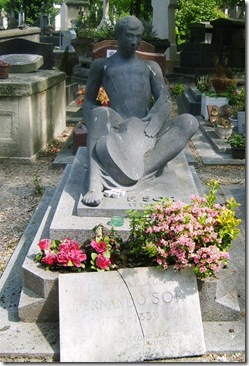

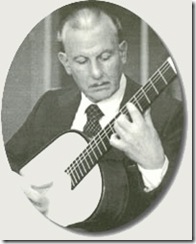
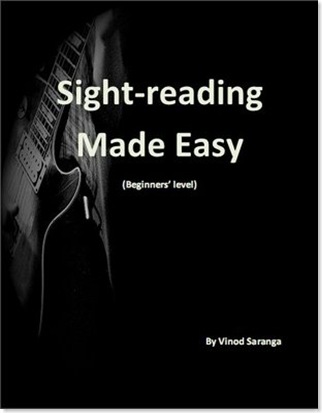

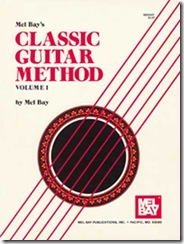
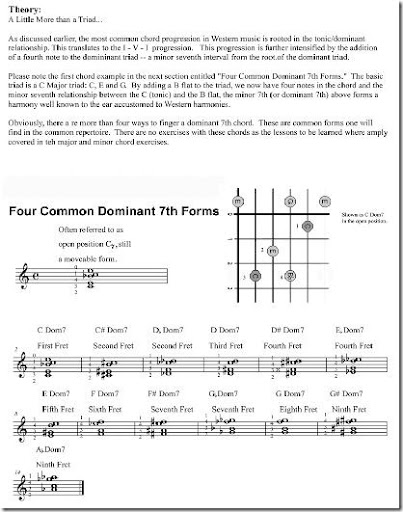
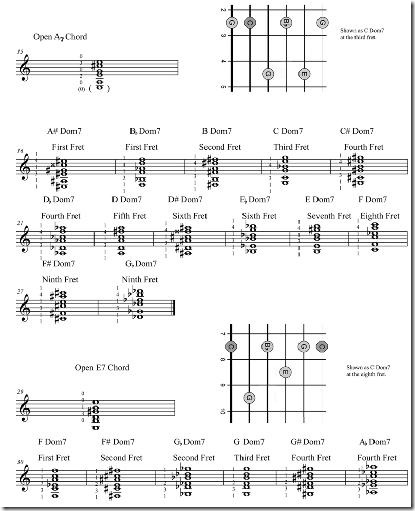
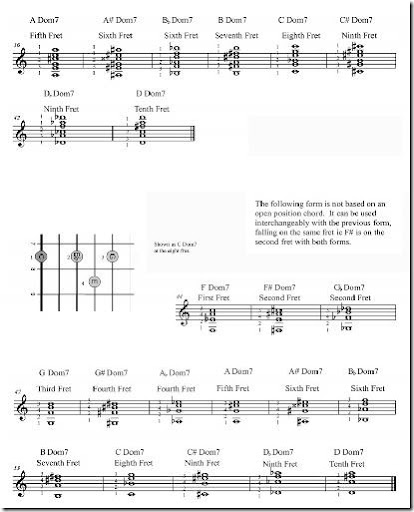
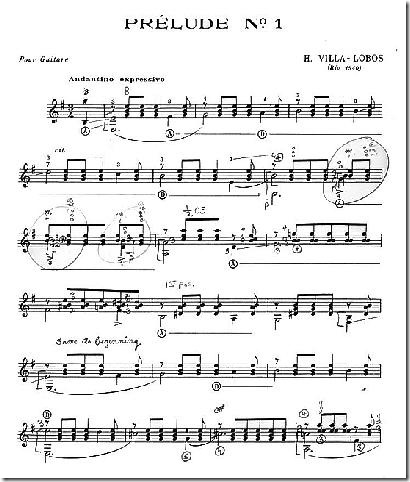
![clip_image001[4]](http://lh6.ggpht.com/hoaddy/SK7Os3F8GrI/AAAAAAAABhs/VSodWdYSCco/clip_image001%5B4%5D_thumb%5B4%5D.jpg)
![clip_image001[6]](http://lh3.ggpht.com/hoaddy/SK7Ou8gtU-I/AAAAAAAABh0/xA7hS-R-q18/clip_image001%5B6%5D_thumb%5B2%5D.jpg)
![clip_image001[8]](http://lh6.ggpht.com/hoaddy/SK7OwhK9pgI/AAAAAAAABh8/L62x7QfMPwQ/clip_image001%5B8%5D_thumb%5B1%5D.jpg)
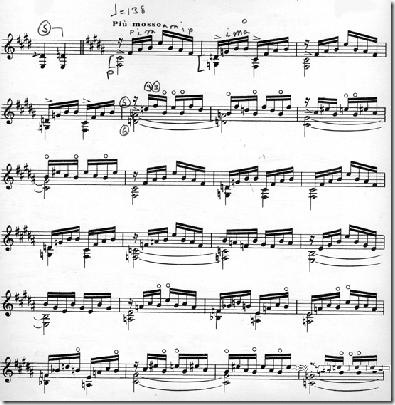
![clip_image001[4]](http://lh6.ggpht.com/hoaddy/SK7Ldwz0jCI/AAAAAAAABhc/QRxulAw-lT0/clip_image001%5B4%5D_thumb%5B3%5D.jpg)

![clip_image001[4]](http://lh6.ggpht.com/hoaddy/SK7H6YeupjI/AAAAAAAABhM/DD-sVCU9k_c/clip_image001%5B4%5D_thumb%5B1%5D.jpg)
